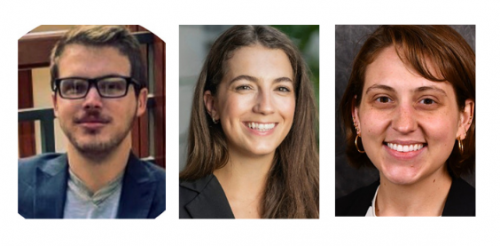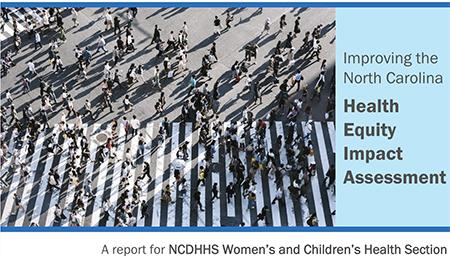
I had heard about the notorious 48-hour memo, before I started at Duke, when I browsed the Duke Sanford YouTube page to learn a little more about the program. Before I accepted my admissions offer, I watched a video of Deandrea Newsome MPP‘20 go through her intensive 48-hour memo with three classmates.

I watched in surprise: they somehow managed to be in the same space for almost two days, and by the end, they had crafted a 10-page memo on a topic that they didn’t know about. I was excited to do this because it seemed like a good bonding experience with my future classmates.
My time came spring semester 2020; this was my second semester at Sanford. I took the class PUBPOL804, colloquially known as the student consulting class. I was assigned randomly to a client and a student team.
My client was the North Carolina Department of Health and Human Services (NCDHHS) and I barely knew my team members --Michael Bennett, Sara McClafferty, and Allison Sokol The rough policy question NCDHHS wanted to explore was “What is impact of using a health equity impact assessment tool to review proposed or current state legislation?” Not knowing any of my team members that well, I was a little nervous going into the assignment. This would be my team for the rest of the semester, so it was critical that we get along.
After receiving our assignment around 4 p.m., we decided to meet at Sara’s apartment to finish the memo. None of us had extensive experience with health policy, so we divided the research. The learning curve was steep, which helped us quickly bond and get to know each other. We laughed to deal with the stress of having to turn in a deliverable so soon.
Refining the Question
We spent a considerable amount of time refining the policy question into something digestible. We also needed to recommend a course of action and our reasons. We combed through literature on health equity impact assessments domestically and abroad. The first couple hours were spent doing the research, and we would take intermittent breaks to get to know each other. Then, we would go through surges of hyper-focus, trying to find the relevant literature.

We went through a group editing process towards the end, putting our memo on Sara’s video monitor. By the time we hit submit, I felt a surge of relief but also gratitude that this would be my team for the class. My favorite part of the experience was working with a team that had different strengths and fun personalities. Allison and Sara focused more on leading team meetings while Mikey and I helped to distract them from the granular minutiae so we wouldn’t dwell on one task too long. Allison and Mikey were always cracking jokes during stressful moments and Sara always checked in on people when she sensed tension or discomfort (a habit from teaching). In sum, the 48 hour memo was a stressful experience, but it solidified the bonds my team would need to work together for the rest of the semester. The video didn’t prepare me for the stress of the experience, the Chik-fil-A fueled breaks we would take and the sheer exhaustion. But, it was a once in a lifetime experience I don’t regret having.
Then, COVID-19 happened. It was the middle of spring break when we learned that the rest of the semester would be conducted virtually. At first, I was in disbelief that our world was collectively experiencing this virus—that there was even in a virus in the first place.
The next question was how we would all adapt to our new learning environments. I had done plenty of group meetings online before, but it felt disruptive to conduct the rest of our work this way. Quickly though, our group adapted. To substitute for the organic interactions we would have had bumping into each other in Sanford, we held more group meetings, more check-ins. We learned about Zoom, confused at first why this was better than Skype. We navigated the inevitable Zoom technology difficulties, the awkward pauses online, the accidentally ending the call prematurely because we didn’t notice our pointer hovering over the red button.
“How are you?” in a pre-Covid world would usually get the expected “Good” and a short summary of what was going on in that person’s day. Now, a simple question felt less comfortable to ask. After all, everyone was stuck inside, so it felt redundant to ask a question that would elicit, “Just at home, staying in.”
Group Dynamics
Naturally, when you are in a class when everyone is assigned a group, you ask your peers how their groups are doing. It’s a nosy way to scope out the dynamics of other groups. Each group had its own dynamics, some being challenging because of personality or work-style incompatibilities.
With my group, though, I lucked out. Despite not being friends with each other at first, we learned each other’s little quirks and working styles. If we were used to leading, we learned how to defer. If we were more meek, we learned how to take the lead. The structure of our group was based on sharing leadership of meetings and deliverables, balancing the concentration of roles within the group.
“Although the experience was extremely time consuming and often times trying mentally and emotionally, I know for a fact that I am much better at working in groups than I was before the process started,” said Allison.
Even though we were each going through our individual struggles with adapting to a coronavirus world, namely the abrupt end of regular social interaction, we persisted with consistent communication with our client. We called our client at NCDHHS (Women and Children’s Section) on a bi-weekly basis to update her on our progress.
“It was an intense experience but definitely pushed me to understand my own strengths and areas of growth when working in a team. The process had enough structure that I didn’t feel totally lost, but it was definitely up to us to communicate with our client and make sure the final product was up to par,” explained Sara.
I learned that health equity often conflicted with the political ideologies of a place. Oftentimes, a health department going into a community talking about “health equity” could come into tension with the prevailing beliefs of the place, namely religion and a firm “that’s just the way it’s always been” kind of mentality.
Final Product
I had no background in health equity going into the project and neither did my team mates. By the end of the project, we delivered a presentation to our client on recommendations to improve the state’s health equity tool. After searching the same keywords on online databases, numerous stakeholder interviews of health departments in North Carolina and out-of-state, and hours spent doing group edits of deliverables, our report, “Improving the North Carolina Health Equity Impact Assessment,” was done. It was the culmination of an intense and often times laborious process.

Our work on health equity emphasized accessibility. We were breaking down concepts heavily steeped in jargon so that people without an MPH degree could access and bring it to their communities. This required slipping off our academic glasses and simplifying concepts, so that they could retain their meaning while maintaining ease of access. I focused on conducting interviews with health departments within North Carolina, and I often thought about how the tool we were working with didn’t take into account the time and resource accessibility of the people using the tool. The tool was dense; it would take days to complete in a group settings, and people would often skip around it because of the overwhelming amount of information.
During this project, I overcame a fear that that lurked from my undergraduate years—working in randomly assigned group projects. I had not-so-savory experiences with incompatible group members and, to put it bluntly, freeloaders. Group work was not something I was fond of. As an introvert, my instinctive tendency wasn’t to work with strangers. So, this project stretched me, bended my capacity in ways I couldn’t imagine. I was able to come together with a group of amazing and very persistent people, and friends by the end, to create a product we were proud of and would have an impact on local North Carolinians.
I interviewed staff in health departments, asking them questions on health equity. Before my first call, my nerves overwhelmed me; sweat pooling on my palms made it difficult to type. I didn’t want to come off as not knowing anything or being incompetent. Fast forward to my last interview: I felt relaxed. Through repetition, I was confident in having a conversation with little structure.
Ultimately, I am grateful for this class, for this experience. I created meaningful friendships with my classmates, while immersing myself in a topic I wouldn’t have thought to tap into. Most importantly, I made an impact on a part of North Carolina, making me feel more like a part of this state that I call home for two years.
Reg Ledesma is a second year MPP student. They graduated from the University of Maryland, College Park in 2018. Before Duke, they lived in Washington, DC, where they worked on the Bernie Sanders campaign.
